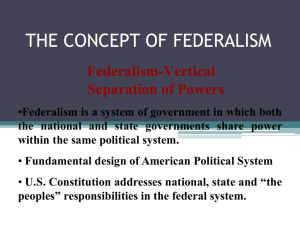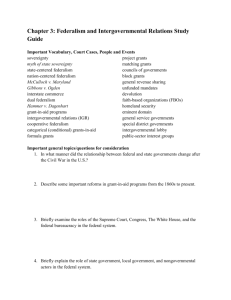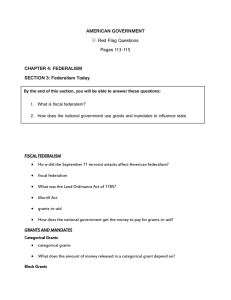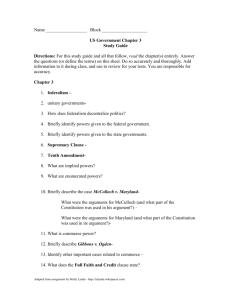Lecture 3 Federalism
advertisement
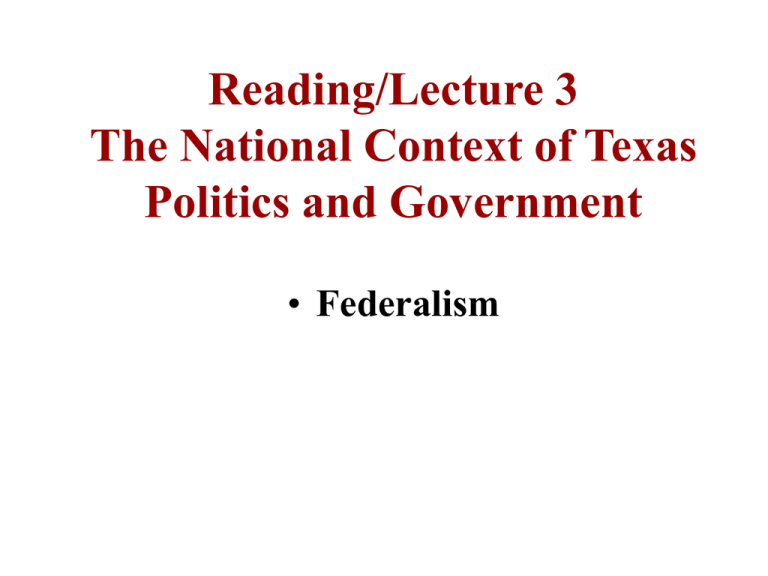
Reading/Lecture 3 The National Context of Texas Politics and Government • Federalism Federalism -Vertical Separation of Powers • Federalism is a system of government in which both the national and state governments share power within the same political system. • Fundamental design of American Political System • U.S. Constitution addresses national, state and “the peoples” responsibilities in the federal system. Three Types of Democratic Government Design • Unitary –Hierarchical –Centralized Power –Subdivisions carry out or enforce policy decisions –UK and Texas • Confederation –Opposite of Unitary –Central Government power derived from states (lower sub units) –Articles of Confederation –Confederacy –United Nations • Federation –Compromise –State Autonomy –Government closer to people –Lacks uniformity in laws –Services vary from state to state Advantages of Federalism • Geography – Political subcultures with different priorities. • Population and layers of governments necessary to fulfill obligations. – Multiple arenas for decision making. • Interstate compacts • States as a “testing lab” for new policies. Federal System Drawbacks • The variance in local policy application has led to a lack of uniform state laws and a demands for national standards. • Many argue that the national government should ultimately control all policy directions. • Leads national government power expansion at states expense. • Powerful state interests can block national initiatives. The Evolution of U.S. Federalism • Dual Federalism – – – – Pre-civil war until Great Depression Issues resolved by Supreme Court National and state governments equal Function and duties clearly divided Early State Power: Economic Regulation • State legislatures regulated economic areas such: – – – – property, contracts, banking, insurance, – incorporation, – credit, – professional practices. State Power over the Individual • States enacted: – criminal statutes, – health and safety regulations, – laws concerning marriage, divorce, birth and adoption. The Depression and the Great Society • The federal government responded with economic and social programs. • The Supreme Court initially ruled that these programs were unconstitutional. • Roosevelt threatened to pack the Supreme Court. • The Supreme Court reversed its position and upheld the constitutionality of the plan. • Ushered in the Democrats “New Deal” Era 20th Century Federalism • Cooperative Federalism – FDR’s New Deal focuses on national and state levels cooperating to solve problems – Grant money begins to flow to states from national government – Gradually national government grows in power and influence over state governments Tools of Power: Federal Mandates and Grants • Federal mandates are federal laws applied to states. • Governmental programs are usually in the form of federal grants-in-aid. • Congress appropriates money to state and local governments to fund particular projects, usually with strings attached. • The “Great Society” greatly increased funded work and social programs such as Medicare, AFDC and Social Security. Types of Grants • Land Grants – During Dual Federalism • Categorical grants specify particular types of projects for which federal funds can be used. – Project grants are a type of categorical grant, which are competitive. – Formula grants are allocated based on need or capacity. – Usually represent 85% of federal grants. • Block grants are grants for broader areas. • Revenue sharing - no mandate or strings attached. New Federalism • New Federalism (Nixon and Reagan) – – – – – – National government too powerful Decentralization of programs Revenue sharing introduced Matching grants “Carrot and stick” approach Unfunded mandates Devolution of Federalism • Uncooperative Federalism – Republican revolution of 1994 – Unfunded Mandate Act of 1995 – Made adoption by Congress more difficult – New pressure on states – To provide more service – To enforce more regulations – To match federal funding – Series of Supreme Court decisions tend to support states and limit national governments power In the 1990s: State v. Feds • Reinforcing 10th Amendment • Stressing dual sovereignty – Reducing power of national government • Limiting federal use if interstate commerce clause – – – – – – – New York v. United States Gregory v. Ashcroft United States v. Lopez Seminole Tribe v. Florida Printz v. United States City of Boerne v. Flores United States v. Morrison • Will war on terrorism reverse this trend?


